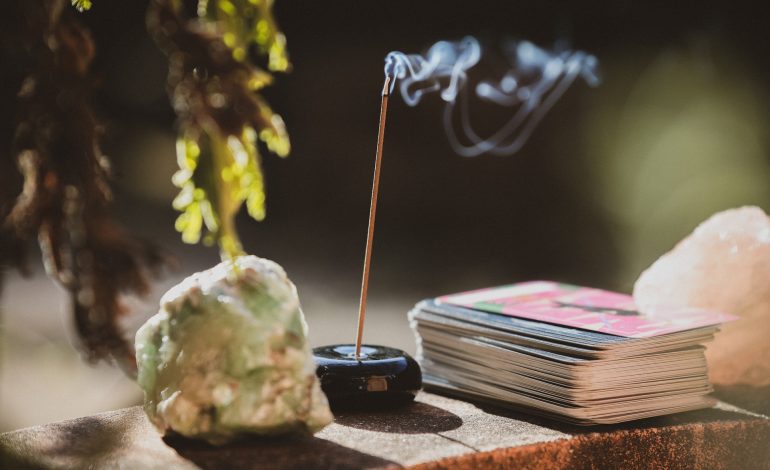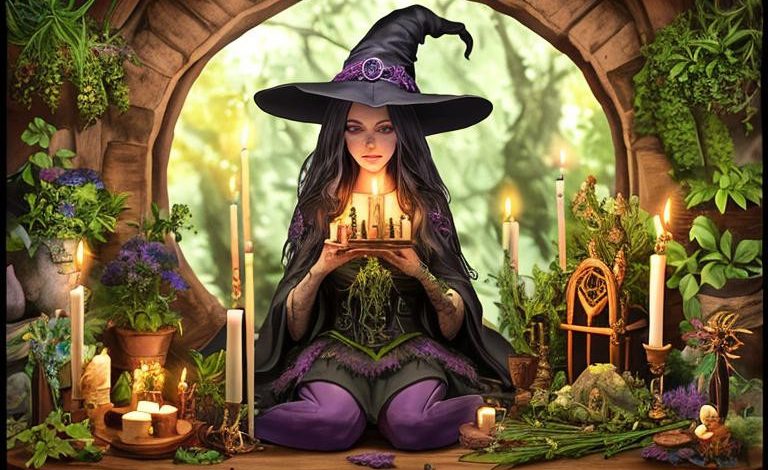
As a Wiccan healer, you have the power to harness the magic of the earth and the plants around us. Herbal magic has been used for centuries to heal the body, mind, and spirit. By understanding the properties of different herbs and incorporating them into your practice, you can connect with the natural world and enhance your healing abilities.
Herbs have been used for thousands of years to treat ailments and promote well-being. In ancient times, healers would rely on the power of nature to create remedies for their patients. They would use plants like lavender and chamomile to promote relaxation and restful sleep, or ginger and peppermint to soothe digestive issues.
As a Wiccan healer, you can use these same herbs and more to create powerful remedies for your clients. You can use herbs to treat physical ailments like headaches and muscle pain, as well as emotional issues like anxiety and depression.
But herbal magic goes beyond just physical healing. Plants and herbs have been used for centuries for spiritual growth and connection to the divine. By incorporating herbs into your spiritual practice, you can deepen your connection to the natural world and enhance your intuition.
One way to use herbs in your practice is through creating herbal tinctures. A tincture is a concentrated liquid extract made from herbs. They are easy to make and can be used to treat a variety of issues, from insomnia to anxiety.
To make an herbal tincture, you will need to gather your chosen herbs and a high-proof alcohol like vodka. You can use fresh or dried herbs, but fresh herbs will provide a more potent extract. Simply chop up the herbs and place them in a jar with the alcohol. Let the mixture sit for several weeks, shaking it occasionally. Once the tincture is ready, strain out the herbs and store the liquid in a dark glass bottle.
Another way to use herbs in your practice is through creating herbal teas. Herbal teas can be used to treat a variety of issues, from stress and anxiety to digestive issues and menstrual cramps.
To create an herbal tea, simply steep your chosen herbs in hot water for several minutes. You can use fresh or dried herbs, but again, fresh herbs will provide a more potent tea. Some popular herbs for tea include chamomile, lavender, peppermint, and ginger.
Herbal teas can also be used for spiritual purposes. For example, you can create a tea using herbs like mugwort and damiana to enhance your psychic abilities and facilitate astral travel.
Another way to use herbs in your practice is through creating herbal baths. Herbal baths can be used to promote relaxation, relieve muscle pain, and cleanse the aura.
To create an herbal bath, simply gather your chosen herbs and place them in a muslin bag or directly in the bath water. You can use fresh or dried herbs, but fresh herbs will provide a more potent bath. Some popular herbs for bath include lavender, chamomile, rosemary, and eucalyptus.
Herbal baths can also be used for spiritual purposes. For example, you can create a bath using herbs like sage and rosemary to purify your aura and remove negative energy.
Another way to use herbs in your practice is through creating herbal oils. Herbal oils can be used for massage, to soothe sore muscles, and to promote relaxation.
To create an herbal oil, simply gather your chosen herbs and place them in a jar with a carrier oil like olive or coconut oil. Let the mixture sit for several weeks, shaking it occasionally. Once the oil is ready, strain out the herbs and store the liquid in a dark glass bottle.
Herbal oils can also be used for spiritual purposes. For example, you can create an oil using herbs like frankincense and myrrh to enhance your connection to the divine.
In addition to using herbs in these various ways, you can also incorporate them into your spell work. Different herbs have different magical properties, and by using them in your spells, you can enhance their power and effectiveness.
For example, rosemary is often used for protection and purification, while lavender is used for peace and relaxation. Mugwort is used for enhancing psychic abilities and facilitating astral travel, while chamomile is used for promoting sleep and reducing stress.
To use herbs in your spells, you can create herb sachets, use them in candle magic, or sprinkle them on your altar. You can also create herbal infusions to use in your spell work.
Herbal infusions are created by steeping herbs in hot water and then using the liquid in your spell work. For example, you could create an infusion using rose petals for love spells, or peppermint for money spells.
It is important to note that when working with herbs for spiritual or magical purposes, it is important to research their properties and use them responsibly. Some herbs can be toxic or have negative side effects, and it is important to only use herbs that are safe and appropriate for your intended use.
In addition to using herbs in your practice, you can also connect with the natural world by spending time in nature. Taking a walk in the woods, meditating in a garden, or even just sitting outside and observing the plants and animals around you can help you to feel more grounded and connected to the earth.
As a Wiccan healer, your connection to the natural world is essential to your practice. By incorporating herbs into your healing work and spiritual practice, you can enhance your connection to the earth and the magic that surrounds us.
Herbal magic is a powerful tool for healing and spiritual growth. By harnessing the power of nature and the plants around us, we can connect with the natural world and enhance our healing abilities. Whether you are using herbs to create tinctures, teas, baths, or oils, or incorporating them into your spell work, the magic of herbs is available to us all.
History of Herbalism
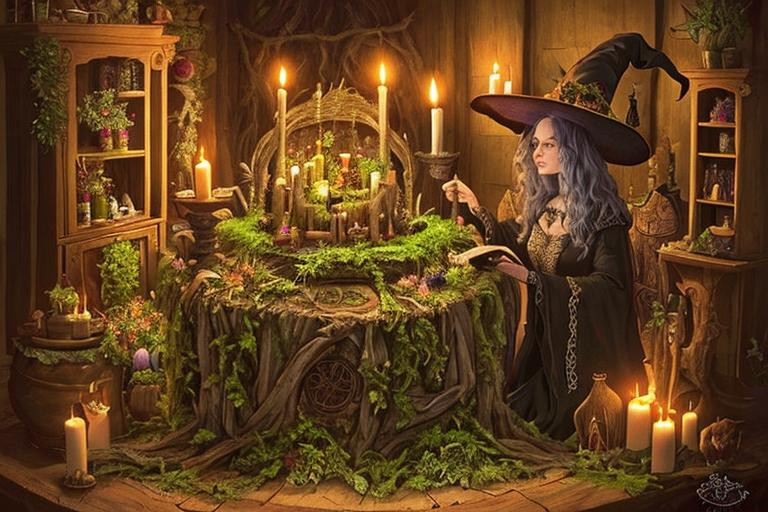
Herbalism is an ancient practice that has been used for healing and spiritual purposes for thousands of years. The use of plants and herbs for medicinal and magical purposes can be traced back to some of the earliest civilizations in human history, including ancient Greece, China, and Egypt.
In ancient Greece, the father of medicine, Hippocrates, wrote extensively about the use of herbs and plants in healing. He believed that the body had the power to heal itself and that plants could be used to support this natural healing process. Many of the remedies he prescribed, such as chamomile for stomach ailments and willow bark for pain relief, are still used today.
In ancient China, traditional medicine relied heavily on the use of herbs and plants. The Chinese believed that everything in nature had a specific purpose and could be used to balance the body’s energy and restore health. Chinese herbal medicine is still widely practiced today and is considered a complementary form of medicine in many parts of the world.
In ancient Egypt, herbs were used not only for healing but also for spiritual purposes. Priests and healers would use herbs and oils in their rituals to connect with the gods and goddesses and to protect themselves from negative energies. Many of the herbs used in ancient Egyptian magic, such as myrrh and frankincense, are still used in modern spiritual practices.
During the Middle Ages, herbalism continued to flourish, and many of the remedies and practices developed during this time are still in use today. The Renaissance saw a renewed interest in herbalism, and many new discoveries were made about the properties of various plants and herbs.
In the 19th and 20th centuries, herbalism fell out of favor with the rise of modern medicine. However, in recent years, there has been a resurgence of interest in herbalism as people seek more natural and holistic approaches to healing.
Herbalism is still an important part of many cultures around the world today. In traditional African medicine, for example, herbs are used to treat everything from headaches to infertility. In Ayurvedic medicine, a traditional system of medicine from India, herbs are used to balance the body’s energy and promote overall health.
In Wiccan and other pagan traditions, herbs are used in spell work and other forms of magic. Each herb is believed to have its own unique properties and energies, which can be harnessed for specific purposes. Herbs are often used in ritual baths, incense, and other magical tools.
Today, herbalism is considered a complementary form of medicine and is often used in conjunction with modern medicine. Many people use herbs and plants to support their overall health and well-being, and there are many different forms of herbal medicine available, from teas and tinctures to essential oils and salves.
Overall, the history of herbalism is a rich and fascinating one, spanning thousands of years and countless cultures around the world. Whether you are using herbs for healing, magic, or simply to connect with the natural world, the power of plants and herbs is a potent one that has been recognized and revered for centuries.
The Magical Properties of Common Herbs
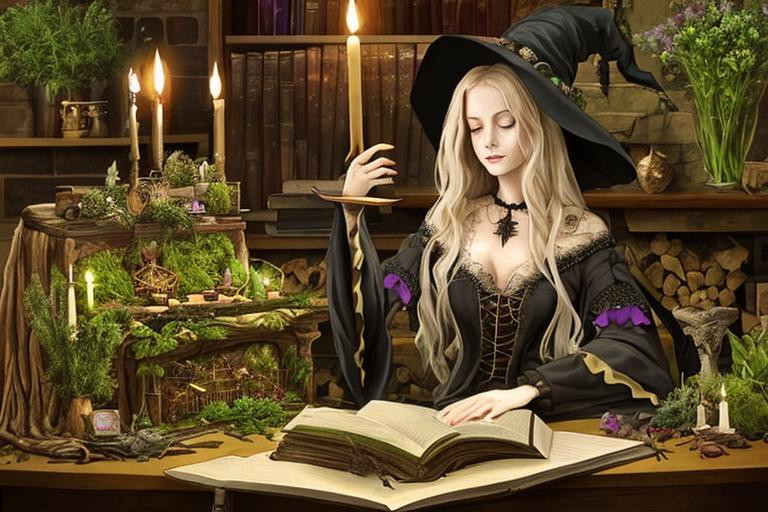
In the world of herbalism and magic, every plant and herb has its own unique properties and energies. These properties can be used to enhance healing and spell work and can help practitioners connect with the natural world in a deeper way. In this article, we will explore the magical properties of some of the most common herbs used in healing and spell work.
Sage – Sage is a powerful herb with strong cleansing and purifying properties. It is often used to clear negative energies and protect against harm. Sage can also be used to enhance intuition and spiritual awareness, making it a popular choice for meditation and divination. Burning sage in a smudging ritual is a common practice in many spiritual traditions.
Thyme – Thyme is a versatile herb with many healing properties. It is often used to boost the immune system and fight off infections. In magic, thyme is associated with courage and strength, and it can be used to help overcome fear and anxiety. Thyme is also believed to bring good luck and can be used in love spells.
Rosemary – Rosemary is a popular herb with many uses in both cooking and healing. It is often used to improve memory and mental clarity and can be used to support brain function. In magic, rosemary is associated with protection and purification and can be used to ward off negative energies and promote healing.
Lavender – Lavender is a calming herb with many healing properties. It is often used to reduce stress and promote relaxation and can be used in aromatherapy to promote restful sleep. In magic, lavender is associated with love and fertility and can be used in love spells or to attract positive energy.
Mint – Mint is a refreshing herb with many medicinal and magical properties. It is often used to soothe digestive issues and can be used to improve mental clarity and focus. In magic, mint is associated with prosperity and abundance and can be used in spells to attract wealth and success.
Chamomile – Chamomile is a gentle herb with many soothing properties. It is often used to promote relaxation and sleep and can be used to calm anxiety and stress. In magic, chamomile is associated with love and can be used in spells to attract a romantic partner or to deepen existing relationships.
Eucalyptus – Eucalyptus is a powerful herb with many healing properties. It is often used to support respiratory health and can be used to ease symptoms of colds and flu. In magic, eucalyptus is associated with purification and can be used to clear negative energies and promote healing.
Ginger – Ginger is a warming herb with many medicinal and magical properties. It is often used to support digestive health and can be used to ease nausea and vomiting. In magic, ginger is associated with love and passion and can be used in spells to increase sexual energy and attraction.
Nettle – Nettle is a nutrient-dense herb with many healing properties. It is often used to support kidney and urinary health and can be used to improve skin health. In magic, nettle is associated with protection and can be used to ward off negative energies and promote healing.
Dandelion – Dandelion is a powerful herb with many detoxifying properties. It is often used to support liver and digestive health and can be used to improve skin health. In magic, dandelion is associated with divination and can be used to enhance psychic abilities and intuition.
Basil – Basil is a popular herb with many culinary and magical uses. It is often used to support digestive health and can be used to ease anxiety and stress. In magic, basil is associated with protection and can be used to ward off negative energies and promote happiness and harmony.
Cinnamon – Cinnamon is a warming spice with many medicinal and magical properties. It is often used to support digestive health and can be used to ease menstrual cramps. In magic, cinnamon is associated with prosperity and can be used in spells to attract wealth and success.
Frankincense – Frankincense is a resin with many healing and spiritual properties. It is often used in meditation and can be used to promote spiritual awareness and connection. In magic, frankincense is associated with purification and can be used to clear negative energies and promote healing.
Myrrh – Myrrh is another resin with many healing and spiritual properties. It is often used to support respiratory health and can be used to ease symptoms of cough and congestion. In magic, myrrh is associated with protection and can be used to ward off negative energies and promote healing.
Lemon balm – Lemon balm is a calming herb with many medicinal and magical properties. It is often used to support mental health and can be used to ease anxiety and depression. In magic, lemon balm is associated with love and can be used in spells to attract a romantic partner or to deepen existing relationships.
Passionflower – Passionflower is a calming herb with many healing properties. It is often used to promote relaxation and sleep and can be used to ease anxiety and stress. In magic, passionflower is associated with love and can be used in spells to attract love and passion.
Yarrow – Yarrow is a versatile herb with many healing and magical properties. It is often used to support wound healing and can be used to ease menstrual cramps. In magic, yarrow is associated with courage and can be used to help overcome fear and anxiety.
Juniper – Juniper is a powerful herb with many healing and spiritual properties. It is often used to support respiratory health and can be used to ease symptoms of cough and congestion. In magic, juniper is associated with protection and can be used to ward off negative energies and promote healing.
Mugwort – Mugwort is a powerful herb with many spiritual and magical properties. It is often used to support dream work and can be used to enhance psychic abilities and intuition. In magic, mugwort is associated with protection and can be used to ward off negative energies and promote healing.
Honeysuckle – Honeysuckle is a fragrant herb with many magical properties. It is often used to promote happiness and harmony and can be used to attract love and friendship. In magic, honeysuckle is associated with prosperity and can be used in spells to attract wealth and success.
These are just a few of the many herbs and plants with magical properties. Whether you are using them for healing or spell work, the energy and power of these herbs can help you connect with the natural world and enhance your spiritual practice. As always, be sure to research and use herbs safely and responsibly, and consult with a qualified herbalist or practitioner if you have any questions or concerns.
The Power of Intention
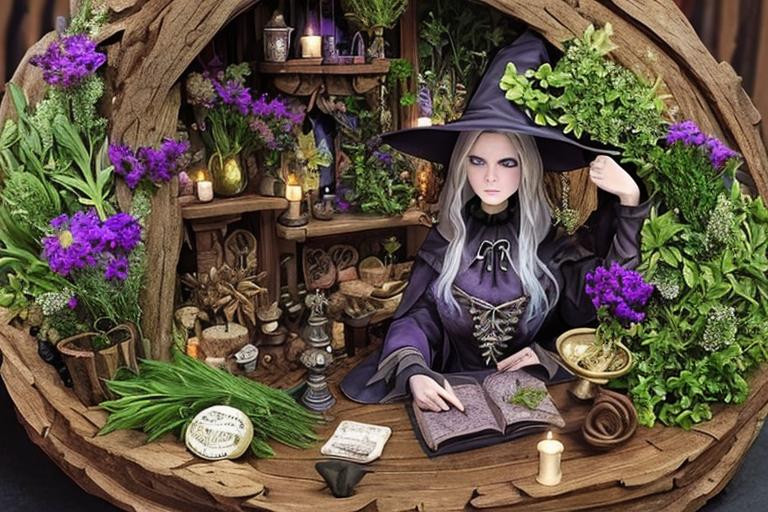
Intention is a powerful force that can greatly enhance your herbal magic practice. It is the energy that you put behind your actions and thoughts, and it is what gives your work with herbs its magical potency. In this article, we will explore the importance of intention in working with herbs for healing and magic, and how to focus your energy to achieve your desired results.
The first step in harnessing the power of intention is to set a clear and specific goal. This goal should be something that is important to you and aligned with your values, as this will give your intention more energy and focus. For example, if you are working with herbs to heal a physical ailment, your goal might be to alleviate your symptoms and promote overall wellness.
Once you have set your goal, it is important to focus your energy and attention on it. This can be done through visualization, meditation, or simply focusing your thoughts and emotions on your goal. The key is to be present in the moment and to direct your energy towards your desired outcome.
Another way to enhance your intention is to use affirmations or mantras. These are short phrases or statements that help to focus your thoughts and emotions on your goal. For example, if you are working with herbs to promote calm and relaxation, you might repeat the affirmation, “I am calm and relaxed” to yourself throughout the day.
When working with herbs, it is important to be mindful of the energy that you are putting into your work. This means using herbs that resonate with your intention and avoiding any herbs or practices that do not align with your goals. For example, if you are working with herbs for prosperity, you might use herbs such as cinnamon, ginger, and basil, which are associated with abundance and prosperity.
Another way to enhance your intention is to work with the phases of the moon. The energy of the moon can greatly enhance the power of your intention, and each phase of the moon is associated with different energies and intentions. For example, the full moon is associated with abundance and manifestation, while the new moon is associated with new beginnings and setting intentions.
When working with herbs for healing and magic, it is important to be mindful of the energy of the plant itself. Each plant has its own unique energy and properties, and it is important to choose herbs that align with your intention and resonate with your energy. You may also want to take into consideration the elemental correspondences of the herbs, such as earth, air, fire, and water, which can enhance the magical properties of the herbs.
In addition to working with herbs, you can also enhance your intention through the use of crystals. Crystals are powerful tools for amplifying and directing energy, and they can greatly enhance the potency of your herbal magic practice. Some crystals that are commonly used in herbal magic include clear quartz, amethyst, and rose quartz.
When working with your intention, it is important to maintain a positive and focused mindset. This means staying open to new experiences and opportunities, and maintaining a sense of gratitude and appreciation for the blessings in your life. By maintaining a positive and focused mindset, you can amplify the power of your intention and manifest your desired outcomes more easily.
Intention is a powerful force that can greatly enhance your herbal magic practice. By setting clear and specific goals, focusing your energy and attention on your intention, and using tools such as affirmations, moon phases, and crystals, you can amplify the potency of your work with herbs and achieve your desired outcomes more easily. Remember to be mindful of the energy of the plants and to maintain a positive and focused mindset, and you will be well on your way to harnessing the power of intention in your herbal magic practice.
Sacred Spaces and Altars
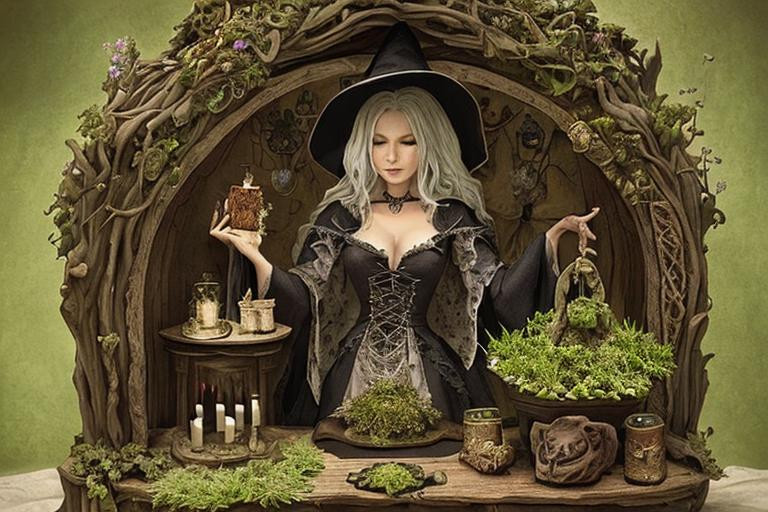
Creating a sacred space for your herbal magic practice is essential to setting the stage for your magical work. It is important to establish a space where you can feel at peace, grounded, and connected to the divine. This sacred space can be anywhere – your bedroom, living room, or even a small corner of your garden. The key is to make it a space that is dedicated solely to your magical practice.
To begin creating your sacred space, start by cleaning and clearing the area. Use sage, palo santo, or another smudging herb to clear out any negative or stagnant energy. Once the space is cleared, you can begin to set up your altar.
An altar is a focal point for your sacred space, a place where you can connect with your spiritual practice. It is a place where you can arrange magical items that hold significance for you, such as crystals, candles, and symbols of the elements. Your altar can be as simple or as elaborate as you like. What matters most is that it resonates with you and your magical practice.
When choosing items to place on your altar, consider the symbolism of each object. For example, a crystal such as amethyst is often associated with spiritual awareness, intuition, and psychic abilities, making it an ideal choice for your altar. Candles are also an important part of your altar, representing the element of fire and the transformational power of the flame.
Once you have set up your altar, take some time to connect with your space. Sit in front of your altar, light a candle, and take a few deep breaths. Visualize the energy of the space, and allow yourself to feel grounded and connected to the earth.
As you work with your sacred space, remember that it is a living, breathing entity. You can add to it and change it as you like, always keeping in mind that your intention and focus are what make it truly magical. You may wish to use herbs to enhance the energy of your sacred space, such as lavender for calming and peace, or rose petals for love and connection.
In addition to your altar, you may wish to create a larger sacred space in your home or garden. This can be a space where you can connect with nature and the elements, and where you can perform your herbal magic work. A garden can be an especially magical space, as you can cultivate your own herbs and connect with the energy of the earth.
When working with herbs in your sacred space, be sure to set your intention and focus your energy on your desired outcome. Use herbs that resonate with your intention, and be sure to thank the earth and the elements for their assistance. You may wish to perform a ritual or meditation in your sacred space, using your altar as a focal point.
Remember that your sacred space is a reflection of your inner world. As you connect with your magical practice, your space will begin to reflect the changes and growth that you experience. Keep it clean and tidy, and always approach it with reverence and respect. Your sacred space is a powerful tool for your magical practice, and can help you to connect with the divine and manifest your desires.
Creating Herbal Remedies
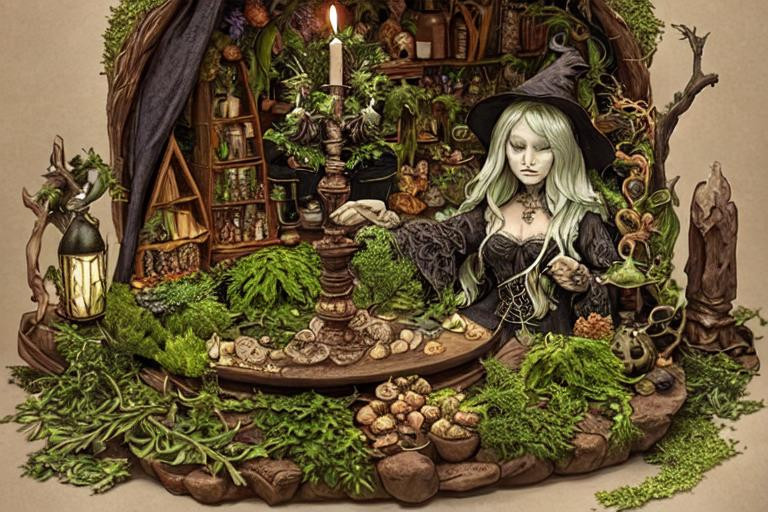
Herbal remedies have been used for centuries to treat a variety of ailments and promote overall wellness. Creating your own herbal remedies can be a magical and empowering experience, allowing you to connect with the healing energy of the plants and create personalized treatments for yourself and others.
Before you begin creating herbal remedies, it is important to have a basic understanding of the properties of different herbs and their potential effects on the body. Research the herbs you plan to use, and consult with a trained herbalist or medical professional if you have any concerns about their safety or effectiveness.
Once you have selected your herbs, you can begin creating your remedies. One of the simplest and most versatile forms of herbal remedies is a tea. To make an herbal tea, simply steep the herbs in boiling water for several minutes. The longer you steep the herbs, the stronger the tea will be. You can add honey or other sweeteners to taste, or mix different herbs together for a more complex blend. Herbal teas can be used to treat a variety of ailments, including stress, anxiety, and digestive issues.
Another common form of herbal remedy is a tincture. Tinctures are alcohol-based extracts of herbs, and are typically more potent than teas. To make a tincture, fill a glass jar with chopped herbs and cover with high-proof alcohol such as vodka. Let the mixture sit for several weeks, shaking occasionally, until the alcohol has extracted the active compounds from the herbs. Strain the mixture and store in a dark glass bottle. Tinctures can be taken directly or added to water or tea, and can be used to treat a variety of conditions including insomnia, pain, and inflammation.
Salves and ointments are another popular form of herbal remedy. These topical treatments are made by combining herbs with a carrier oil and beeswax to create a healing balm. To make a salve, heat the carrier oil (such as olive or coconut oil) and beeswax in a double boiler until the wax has melted. Add the herbs and continue to heat until the oil has infused with the herbs. Strain the mixture and pour into small jars to cool and solidify. Salves can be applied directly to the skin to treat minor cuts, burns, and other skin conditions.
When creating herbal remedies, it is important to set your intention and focus your energy on the healing properties of the herbs. You can enhance the magical properties of your remedies by incorporating visualization, chanting, or other rituals into the creation process. For example, you may wish to visualize the healing energy of the herbs infusing your body as you drink a tea, or recite a healing chant while creating a salve.
In addition to creating remedies for specific ailments, you can also create herbal blends for overall wellness and balance. For example, a blend of chamomile, lavender, and lemon balm can promote relaxation and ease anxiety, while a blend of ginger, turmeric, and cinnamon can support digestion and reduce inflammation. Experiment with different blends and listen to your body’s response to find the combinations that work best for you.
Remember that creating herbal remedies is a powerful act of self-care and healing. Approach the process with mindfulness and intention, and always consult with a trained herbalist or medical professional if you have any concerns about the safety or effectiveness of the herbs you plan to use. With a little bit of knowledge and practice, you can harness the magical power of herbs to promote health and wellness in your life.
Harvesting and Storing Herbs
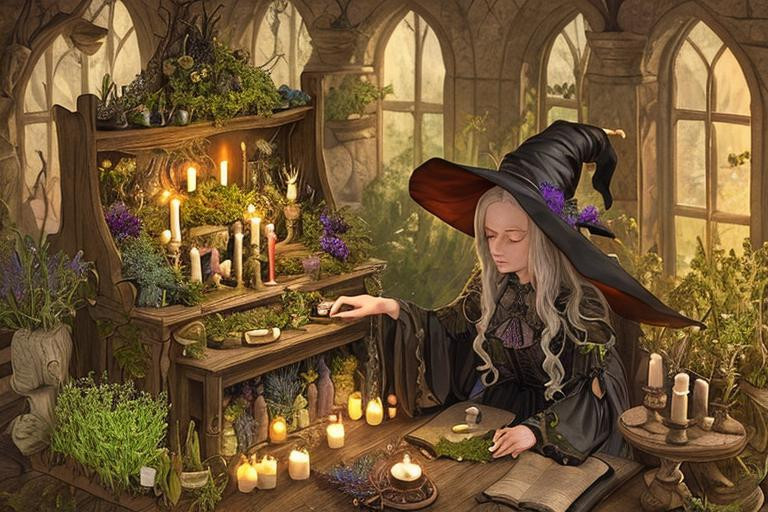
Herbs have been used for centuries for their medicinal and magical properties, and their power can be harnessed by anyone who knows how to work with them. However, before you can start using herbs for healing and magic, it’s important to know how to properly harvest and store them. In this guide, we’ll explore the best practices for harvesting and storing herbs to ensure they retain their potency and effectiveness.
Harvesting herbs is an important step in the process of working with them. It’s essential to know the best time to harvest your herbs, which is typically when they are in full bloom and have reached their peak potency. Herbs should be harvested in the morning, after the dew has evaporated but before the heat of the day has set in. It’s also important to use sharp, clean tools to avoid damaging the plants and to minimize the risk of introducing harmful bacteria or pests.
When harvesting herbs, it’s important to show respect for the plants and to ask for their permission before taking them. You can do this by offering a prayer or a token of gratitude, such as a small crystal or a piece of ribbon. By acknowledging the plant’s power and asking for its blessing, you create a deeper connection to the plant and increase its effectiveness in your work.
Once you’ve harvested your herbs, it’s important to process them properly to ensure they retain their potency. Depending on the type of herb and the intended use, you may need to dry, freeze, or store your herbs in oil or alcohol. Drying herbs is a popular method for preserving them, as it removes moisture and prevents mold or bacteria growth. To dry herbs, tie them in small bundles and hang them upside down in a warm, dry place out of direct sunlight.
If you prefer to store your herbs fresh, it’s important to keep them in a cool, dry place away from direct sunlight. Fresh herbs can be stored in a jar with a small amount of water in the bottom, or wrapped in damp paper towels and stored in a plastic bag in the refrigerator. However, fresh herbs have a shorter shelf life than dried herbs and may need to be used within a few days to retain their potency.
Another popular method for preserving herbs is to infuse them in oil or alcohol. This can be done by placing herbs in a jar and covering them with oil or alcohol, then allowing the mixture to sit for several weeks. The resulting infusion can be used in a variety of ways, such as in salves, tinctures, or as a massage oil.
When storing herbs, it’s important to label them properly to avoid confusion and to ensure you use the right herb for the intended purpose. Label each jar or container with the name of the herb, the date of harvest, and any additional information about the plant or its use. This will help you keep track of your herbs and ensure they remain effective for future use.
In addition to proper harvesting and storage techniques, it’s important to approach your work with herbs with respect and intention. Before using any herb for healing or magic, take the time to connect with the plant and set your intention for the work you’re about to do. Ask the plant for its guidance and permission, and be mindful of the energy you bring to the work. By working with herbs in a respectful and intentional way, you can tap into their full power and create truly transformative healing and magic.
Herbal Magic and the Chakras
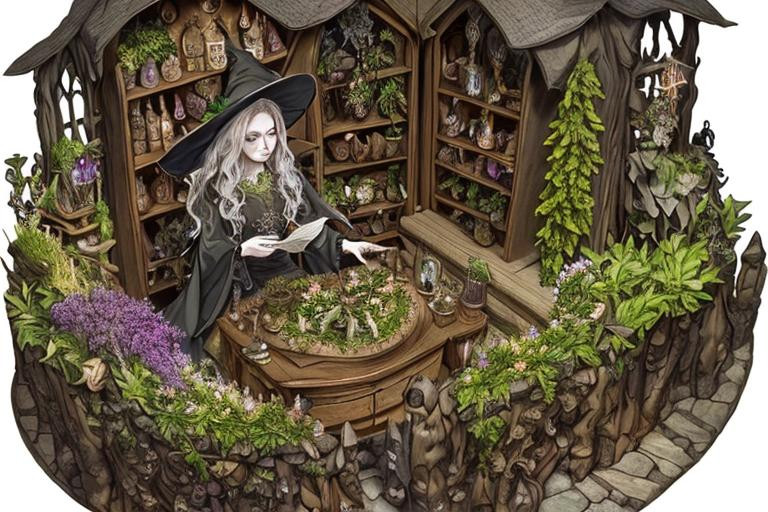
Herbs have long been used in healing and magic, and their power can be further enhanced when combined with energy work. The chakras, or energy centers in the body, are an important aspect of many spiritual and healing practices, and herbs can be used to balance and activate these centers.
Each of the seven main chakras is associated with specific qualities and can be influenced by specific herbs. Here are some examples of herbs that can be used to work with the chakras:
- Root Chakra: The root chakra is associated with grounding, stability, and physical health. Herbs that can be used to balance and activate this chakra include ginger, ginseng, and ashwagandha.
- Sacral Chakra: The sacral chakra is associated with creativity, pleasure, and emotional balance. Herbs that can be used to work with this chakra include damiana, vanilla, and hibiscus.
- Solar Plexus Chakra: The solar plexus chakra is associated with personal power, self-esteem, and confidence. Herbs that can be used to balance and activate this chakra include chamomile, peppermint, and rosemary.
- Heart Chakra: The heart chakra is associated with love, compassion, and connection. Herbs that can be used to work with this chakra include rose, lavender, and hawthorn.
- Throat Chakra: The throat chakra is associated with communication, self-expression, and authenticity. Herbs that can be used to balance and activate this chakra include sage, eucalyptus, and peppermint.
- Third Eye Chakra: The third eye chakra is associated with intuition, psychic abilities, and spiritual insight. Herbs that can be used to work with this chakra include mugwort, lavender, and passionflower.
- Crown Chakra: The crown chakra is associated with connection to the divine, spiritual awakening, and enlightenment. Herbs that can be used to balance and activate this chakra include frankincense, myrrh, and lotus.
Incorporating herbal magic into your chakra work can be as simple as brewing a tea with the appropriate herbs or creating a sachet to carry with you. You can also incorporate herbs into your meditation or energy work practice by placing them on your chakras or using them to create a healing bath or massage oil.
When working with herbs for chakra work, it is important to set an intention and focus your energy on the desired outcome. Visualize the herbs working with your chakras to bring balance and harmony to your energy centers.
Herbal magic and chakra work can be a powerful combination for healing and spiritual growth. By incorporating herbs into your energy work practice, you can deepen your connection to the natural world and tap into the healing power of plants.
Magical Herbal Tea Recipe for Healing and Relaxation
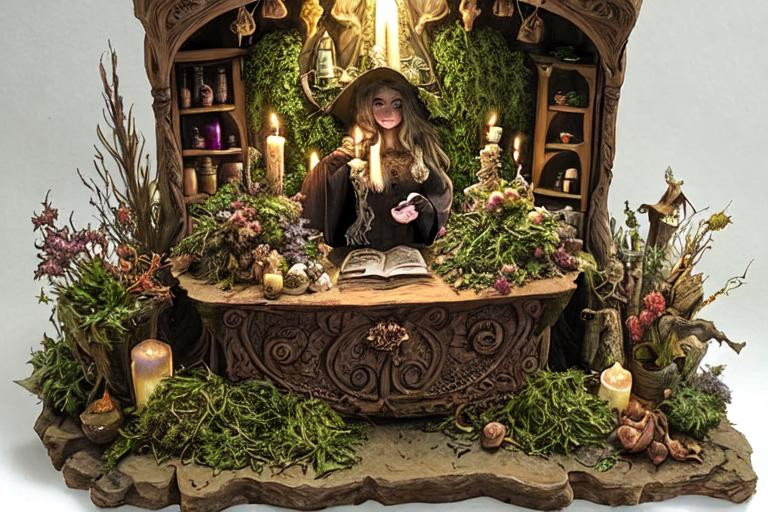
This herbal tea recipe is a powerful blend of soothing chamomile, calming lavender, refreshing peppermint, mood-enhancing lemon balm, and immune-boosting rose petals. Sip on this magical brew to promote healing, relaxation, and overall wellness.
Ingredients:
1 teaspoon of dried chamomile flowers
1 teaspoon of dried lavender flowers
1 teaspoon of dried peppermint leaves
1 teaspoon of dried lemon balm leaves
1 teaspoon of dried rose petals
4 cups of filtered water
Raw honey to taste (optional)
Instructions:
In a medium pot, bring the water to a boil.
Once boiling, turn off the heat and add all the dried herbs to the pot.
Cover the pot and let the herbs steep for 10-15 minutes.
Strain the tea into a teapot or individual cups.
Add raw honey to taste, if desired.
This herbal tea blend is a powerful combination of herbs that are known for their healing properties. Chamomile and lavender are calming and can help soothe anxiety and promote relaxation. Peppermint is known for its digestive benefits and can help alleviate bloating, gas, and stomach discomfort. Lemon balm is a natural mood enhancer and can help improve mental clarity and focus. Lastly, rose petals are high in vitamin C and antioxidants, making them a great immune booster.
Sip on this herbal tea blend throughout the day to promote overall health and wellness. Enjoy the delicious taste and healing benefits of this herbal remedy.
Final Musings:
As you delve deeper into the world of Herbal Magic, you will find that the possibilities are endless. With each herb and plant holding its own unique properties and energies, the opportunities for healing and spiritual growth are limitless. Remember to always work with intention and respect for the natural world, and you will find that the universe will provide you with abundance and wonder.
As you close your eyes and take a deep breath, allow yourself to feel the energy of the earth pulsing through your veins. Know that the power of the universe is within you, and that through Herbal Magic, you can harness that power to create a life full of love, healing, and magic.
So go forth, witches, and explore the enchanting world of Herbal Magic. May your journey be filled with wonder and wisdom, and may the spirits of the earth guide you on your path. Blessed be.

